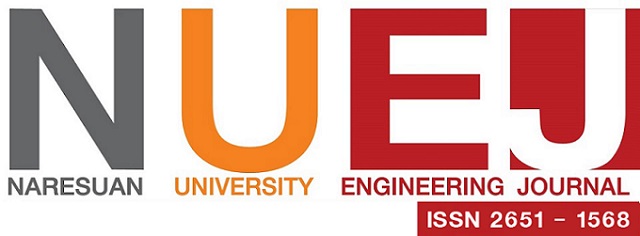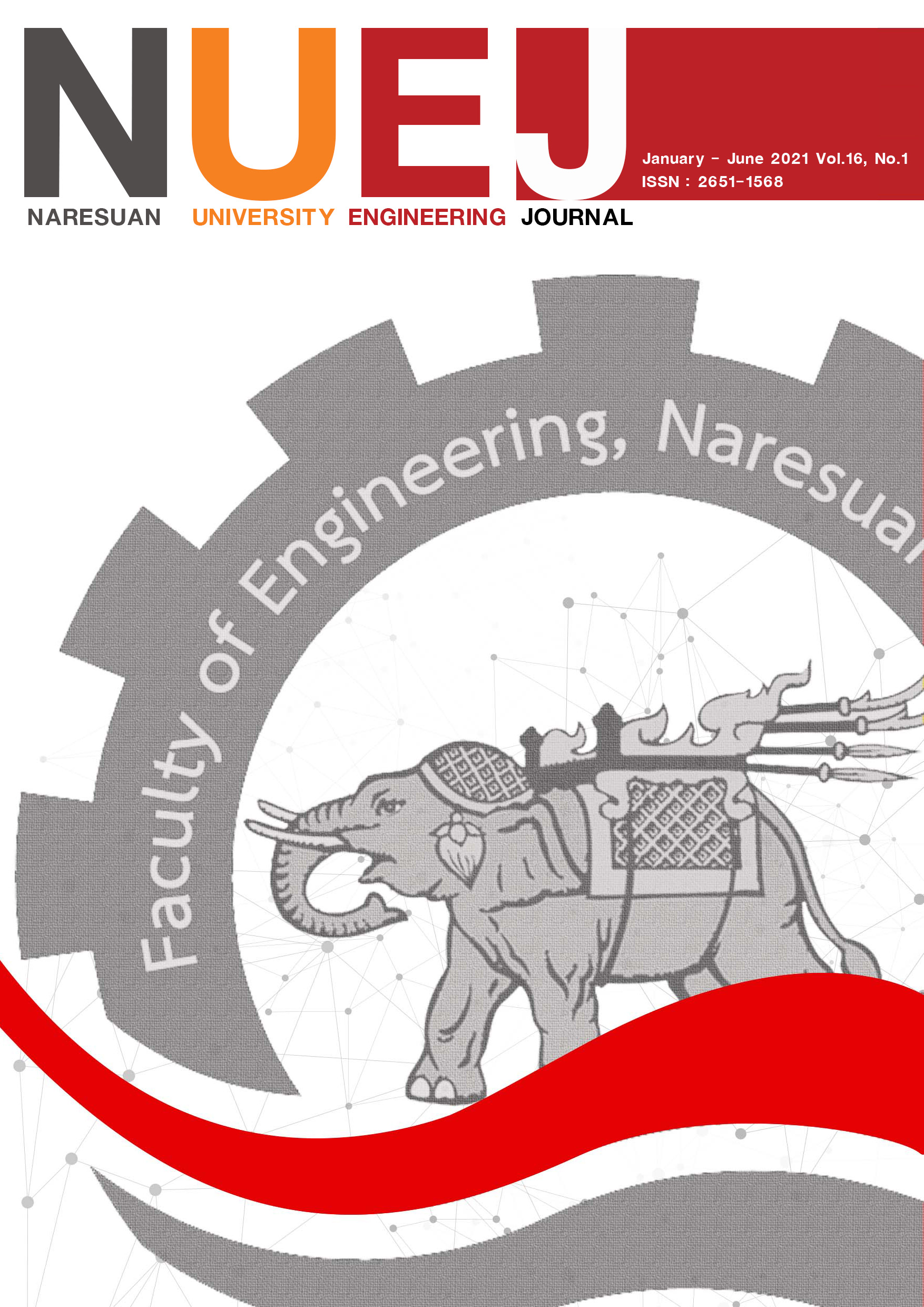แอพลิเคชั่นทดลองสวมใส่เครื่องประดับบนสมาร์ทโฟนด้วยเทคโนโลยีความจริงเสริม
Main Article Content
บทคัดย่อ
บทความนี้นำเสนอการพัฒนาแอพลิเคชั่นทดลองสวมใส่เครื่องประดับบนสมาร์ทโฟนด้วยเทคโนโลยีความจริงเสริม (Augmented Reality) เพื่อให้ลูกค้าของผู้ประกอบการธุรกิจเครื่องประดับทางออนไลน์ทดลองสวมใส่เครื่องประดับได้เสมือนจริง เพิ่มโอกาสในการขายสินค้า ระบบที่พัฒนาขึ้นใช้เทคโนโลยีความจริงเสริมแบบไม่ใช้ตัวระบุตำแหน่ง (Marker) และประยุกต์ใช้เทคนิคการรู้จำในการตรวจจับมือของผู้ใช้งาน และนำข้อมูลที่สำคัญไปจัดทำโมเดลชิ้นงานเครื่องประดับแบบสามมิติ ผ่านการเรนเดอร์ผิวของโมเดลให้มีความสมจริง และสามารถปรับเปลี่ยนแบบและขนาดได้ตามความต้องการของลูกค้า ซึ่งวิธีการนี้ทำให้มีตุ้นทุนการผลิตต่ำกว่ารูปแบบเดิม ความถูกต้องแม่นยำของการวางโมเดลสามมิติของแหวนบนตำแหน่งของนิ้วมือเท่ากับร้อยละ 94.17 โดยเฉลี่ย ความถูกต้องแม่นยำในเรื่องของการวางโมเดลสามมิติของกำไลบนตำแหน่งของข้อมือ ร้อยละ 100 จากการทดสอบการใช้งานกับกลุ่มเป้าหมาย ประกอบด้วยผู้ประกอบการจำหน่ายเครื่องประดับและลูกค้าผู้ซื้อ พบว่า มีความพึงพอใจมากที่สุดในเรื่องของความง่ายในการใช้งาน และสร้างความมั่นใจในการตัดสินใจซื้อสินค้า และมีความพึงพอใจมากในเรื่องของความสมจริงในการทดลองสวมใส่
Article Details
References
Chatzopoulos, D., Bermejo, C., Huang, Z., & Hui P. (2017). Mobile Augmented Reality Survey: From Where We Are to Where We Go. IEEE Access, 5, 6917–6950.
Foxlin, E., Altshuler, Y., Naimark, L., & Harrington, M. (2004). Flight Tracker: A Novel Optical/Inertial Tracker for Cockpit Enhanced Vision. Third IEEE and ACM International Symposium on Mixed and Augmented Reality (pp. 212–221). Arlington, VA, USA. https://doi.org/10.1109/ISMAR.2004.32
Gans, E., Roberts, D., Bennett, M., Towles, H., Menozzi, A., Cook, J., & Sherrill, T. (2015). Augmented reality technology for day/night situational awareness for the dismounted Soldier. International Society for Optics and Photonics, 9470, 947004.
Klopfer, E., Perry, J., Squire, K., Jan, M.-F., & Steinkuehler, C. (2015). Mystery at the museum: a collaborative game for museum education. Proceedings of the 2005 Conference on Computer Support for Collaborative Learning. (pp. 316-320). Taipei, Taiwan. https://doi.org/10.3115/1149293.1149
Pretto, F., Manssour, I. H., Lopes, M. H. I., da Silva, E. R., & Pinho, M. S. (2009). Augmented reality environment for life support training. Proceedings of the 2009 ACM symposium on Applied Computing - SAC (pp. 836-841). Honolulu, Hawaii, USA. https://doi.org/10.1145/1529282.1529460
Khalifa, F. A., Semary, N. A., El-Sayed, H. M., & Hadhoud, M. M. (2016). Markerless Tracking for Augmented Reality Using Different Classifiers. Springer.
Nakamura, H., & Miyashita H. (2010). Control of augmented reality information volume by glabellar fader. https://dl.
acm.org/doi/10.1145/1785455.1785475
Dacre, K., & Urwin, R. (2018). Magic mirrors, 25 staircases and a giant 22ft screen - Burberry flagship store lands in Regent Street | London Evening Standard. https://www.standard.
co.uk/news/london/magic-mirrors-25-staircases-and-a-giant-22ft-screen-burberry-flagship-store-lands-in-regent-street-8134688.html
Livingston, M. A., Rosenblum, L. J., Julier, S. J., Brown, D., Baillot, Y., Swan Ii, J. E., Gabbard, J. L., & Hix, D. (2005). An Augmented Reality System for Military Operations in Urban Terrain. https://apps.dtic.mil/sti/citations/ADA499032
Bajura, M., Fuchs, H., Ohbuchi, R., Bajura, M., Fuchs, H., & Ohbuchi, R. (1992). Merging virtual objects with the real world. ACM SIGGRAPH Computer Graphics, 26(2), 203–210.
Billinghurst, M., & Duenser, A. (2012). Augmented Reality in the Classroom. Computer (Long Beach, Calif), 45(7), 56–63.
Billinghurst, M., Hakkarainen, M., & Woodward, C. (2008). Augmented assembly using a mobile phone. Proceedings of the 7th International Conference on Mobile and Ubiquitous Multimedia - MUM ’08 (pp. 167-168). Cambridge, UK. https://doi.org/10.1109/ISMAR.2008.46373
Hakkarainen, M., & Woodward, C. (2005). SymBall: camera driven table tennis for mobile phones. In ACM International Conference Proceeding Series, 265, 391-392.
Chen, P., Liu, X., Cheng, W., & Huang, R. (2017). A review of using Augmented Reality in Education from 2011 to 2016. Innovations in smart learning, 2017, 13–18.
Farrington, P., Nembhard, H., Sturrock, D. T., Evans, G. W., & Standridge, C. R. (1999). A Tutorial On Simulation in Health Care: Applications and Issues. Proceedings of the 1999 Winter Simulation Conference (pp. 49-55). Association for Computing Machinery. https://doi.org/ 10.1145/324138.324
Cavallaro, R., Cavallaro, R., Hybinette, M., & White, M. (2011). Augmenting live broadcast sports with 3D tracking information. IEEE MultiMedia, 18(4), 38.
Varadarajan, R., Srinivasan, R., Vadakkepatt, G. G., Yadav, M. S., Pavlou, P. A., Krishnamurthy, S., & Krause, T. (2010). Interactive technologies and retailing strategy: A review, conceptual framework and future research directions. Journal of Interactive Marketing, 24(2), 96-110.
Wen, R., Tay, W.-L., Nguyen, B. P., Chng, C.-B., & Chui, C.-K. (2014). Hand gesture guided robot-assisted surgery based on a direct augmented reality interface. Computer Methods and Programs in Biomedicine, 116(2). 68–80.
Chien, S., Choo, S., Schnabel, M. A., Nakapan,W. M., Kim, J., Roudavski, S. (Eds.). (2016). Living Systems and Micro-Utopias: Towards Continuous Designing. Proceedings of the 21st International Conference on Computer-Aided Architectural Design Research in Asia (CAADRIA 2016) (pp. 918). The University of Melbourne, Australia. http://papers.
cumincad.org/data/works/att/caadria2016_000.pdf
Henderson, S. J., & Feiner, S. K. (2011). Augmented reality in the psychomotor phase of a procedural task. Proceedings of the 2011 10th IEEE International Symposium on Mixed and Augmented Reality (pp. 191–200). Basel, Switzerland. https://doi.org/10.1109/ISMAR.2011.6092386
Yohan, S. J., Yohan, S. J., Julier, S., Baillot, Y., Lanzagorta, M., Brown, D., & Rosenblum, L. (2000). Bars: Battlefield augmented reality system. https://citeseerx.ist.psu.edu/
viewdoc/download?doi=10.1.1.1.5064&rep=rep1&type=pdf
Webel, S., Bockholt, U., Engelke, T., Gavish, N., Olbrich, M., & Preusche, C. (2013). An augmented reality training platform for assembly and maintenance skills. Robotics and Autonomous Systems, 61(4), 398–403.
Yusuke, S., Fukuda, T., Yabuki, N., Michikawa, T., & Motamedi, A. (2016). A Marker-less Augmented Reality System using Image Processing Techniques for Architecture and Urban Environment. Proceedings of the 21st International Conference on Computer-Aided Architectural Design Research in Asia (CAADRIA 2016) (pp. 713-722). Hong Kong. http://papers.cumincad.org/data/works/att/caadria2016_713.pdf
Piekarski, W., & Thomas, B. (2002). ARQuake: the outdoor augmented reality gaming system. Communications of the ACM, 45(1), 36-38.

